
| home |
 |
 |
This measures the area in the center of
a picture being taken, which comprises 2% of the total picture area. This
is approximately the area covered by the microprism of a standard focusing
screen. The simplest application of Spot Meter function. The camera is pointed at the critical area of the composition and the Spot Button is pressed to take a spot reading.
|
||
|
|
|||
|
|
This allows the photographer to measure the light intensity at several different areas in a composition. Up to eight readings can be recorded, they are averaged for the final exposure value. This is used to obtain optimum exposure in situation where the subjects are in different light levels. For example, you may want to take into account both the flesh tones and the clothing of a model. Point the camera at each area you wish to measure and press the Spot Button. For extra emphasis on one of the areas, press the Spot Button twice or more. This gives the ideal compromise between different elements.
|
||
|
|
|||
| These functions are used to accentuate exceptionally bright or dark elements in a photograph. |
|
"Exposure control is of very great importance to accurate recreation of what our eyes see. Because of uneven distribution of light and dark within a scene the camera will actually often record what is bright as thought it were dark! The OM-4 SLR will help counteract that, by means of averaging several spot readings, and by its exposure memory. But no camera maker can compensate for the problem of the human mind : if you and I stand before the same scene we will each see it in a different way - because of the experiences and the interpretations programmed into our minds. It is therefore necessary to provide a camera which will allow the photographer sufficient choice and control to recreate accurately the scene as he interprets it."
"By pressing one button on a washing machine a housewife may soak, wash, rinse, spin dry, all her fabrics. But the machine washes everything in the same way : it takes no account of how much dirt is in this or that, and it cares even less whether it tumbles silk or denim or wool. It cannot differentiate within one programme, or one mode. TTL metering is similar : it measures the light and sets the camera according to its programmed "brain". Automation, of course - but the first stage only. In the second phase the will of the user is very important, and must be integral with the camera's automatic way of doing things. Choice must be available, so that the photographer may remain master of the situation : but automation must be available too, so that the camera will quickly and accurately do whatever the photographer wishes it should do, so speeding up his picture taking, reducing human error." |
|
|
The mirror
consists of a main, beamsplitting mirror and a smaller fresnel mirror
hinged to its back. The main mirror passes through 20% of the light it
receives. This light is collected by the fascinating optical surface of
the fresnel mirror and reflected to the complex photo cell in the base
of the camera. The fresnel mirror
is a composite mirror developed to assure accurate fulfillment of both
spot metering and center-weighted average metering functions. The central
part is made up of an aspherical fresnel mirror laid out in a mosaic pattern,
while the periphery consists of a pyramid type reflecting surface with
diffusion characteristics. |
||
|
|
|||
 |
The
Silicon Blue Cell is really two cells in one; a tiny circular cell at the
center and a much larger cell surrounding it. The circular cell produces
the spot readings. The combination of the signals from the two cells produce
center-weighted average readings from the whole scene. A tiny molded plastic
lens system is used to collect light for the complex photo cell. It is a
one-piece molding containing three air-spaced positive lenses. The photo cell undertakes three different functions: For the center-weighted average meter readings shown in the viewfinder, it reads all the light that passes through the central half-mirror section of the main mirror. In TTL Direct OTF Light Measuring mode, it takes a center-weighted average reading directly off the film plane when the mirror is raised and during the exposure. And for spot metering, an electronic command changes the area covered to the central part of the picture only. |
|
In shooting backlit shots, Full Synchro Flash allows photographer to select the exact shutter speed and aperture for the shot, providing just the action-stopping and depth-of-field effects they desired. Because ordinary electronic flash is so brief, it is good for freezing action. But at lower synchro shutter speeds the available light level can sometimes cause the subject blur. Full Synchro Flash allows photographer to set a high shutter speed, eliminating any risk of blurred action shots. On the other hand, by lowering the shutter speed and taking advantage of the long flashing time, movement in flash photography can be achieved. In ordinary electronic flash system, the flash emission is almost discharged instantaneously. At shutter speeds higher than the synchro speed, the flash light can only expose part of the picture. With the old style flash bulb, there was no problem because its output lasted long enough to cover the time taken by the movement of the shutter curtains. This is what gives Olympus engineers their clue. Instead of just one flash emission per discharge, the F280 produces thousands of pulses, perfectly timed so that the level of illumination remains constant from start of finish. |
|
|
The design of F280 takes three years and involves forty new patents. The design team first examines the characteristics of the xenon flash tube, including optimal gas pressure, flash duration and emission cycle. After extensive testing, they settle on a flash duration of 1/25sec(40 millisecond) and an average of 20, 000 emissions per second. The two semiconductors used in F280 are specially developed, one to control emission intervals and another to relay data from the camera body to the flash. A new energy-saving circuit is developed, it saves electric charges used for emission and stores them for the next. |
  |
||||
| OM-3 (1984) |
OM-4 (1983) |
OM-3Ti (1994) |
OM-4Ti (1986)
OM-4Ti Black (1989) |
|
| Multi
Spot Metering Mechanical shutter |
Multi
Spot Metering TTL OTF Metering |
Titanium
body shell Full Synchro Flash Mechanical shutter New focusing screen |
Titanium
body shell Full Synchro Flash Improved circuit |
| | OM concept - stage 3 | anatomy | | |||
| | OM concept | OM-1 | OM-2 | OM-3, OM-4 | OM lenses | OM catalog | OM adv | OM interview | | |||
| |
suggestions | | home | Last updated on 28 May, 2003 |
|||